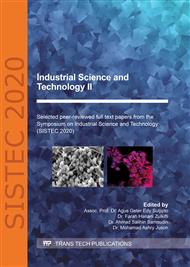[1]
Maaroff R, Jamaliah Md Jahim, Azratul Madihah Azhar, Peer Mohamed Abdul, Mohd Shahbudin Masdar, Darman Nordin, et al. Biohydrogen production from palm oil mill effluent (POME) by two stage anaerobic sequencing batch reactor (ASBR) system for better utilization of carbon sources in POME. International Journal of Hydrogen Energy. 2019;44:3395-406.
DOI: 10.1016/j.ijhydene.2018.06.013
Google Scholar
[2]
Enitan A. Microbial community analysis of a UASB reactor and application of an evolutionary algorithm to enhance wastewater treatment and biogas production. Durban University of Technology. (2014).
DOI: 10.51415/10321/1276
Google Scholar
[3]
Klocke M, Mahnert P, Mundt K, Souidi K, Linke B. Microbial community analysis of a biogas-producing completely stirred tank reactor fed continuously with fodder beet silage as mono-substrate. Systematic Applied Microbiology. 2007;30:139-51.
DOI: 10.1016/j.syapm.2006.03.007
Google Scholar
[4]
Guo F, Wang Z-P, Yu K, Zhang T. Detailed investigation of the microbial community in foaming activated sludge reveals novel foam formers. Scientific Reports. 2015;5:7637.
DOI: 10.1038/srep07637
Google Scholar
[5]
Cai M, Wilkins D, Chen J. Metagenomic reconstruction of key anaerobic digestion pathways in municipal sludge and industrial wastewater biogas-producing systems. Frontiers in Microbiology. 2016: 778.
DOI: 10.3389/fmicb.2016.00778
Google Scholar
[6]
Revanuru S, Mishra IM. Treatment of catehol bearing wastewater in an upflow anaerobic sludge (UASB) reactor: sludge characteristic. Bioresource Technology. 2008; 99:8917-25.
DOI: 10.1016/j.biortech.2008.04.067
Google Scholar
[7]
Sawajneh Z, Al-Omari A, Halalsheh M. Anaerobic treatment of strong sewage by a two stage system of AF and UASB reactors. Water Science and Technology. 2010;61:2399-406.
DOI: 10.2166/wst.2010.051
Google Scholar
[8]
Neptune. Neptune Systems Apex AquaController System. https://www.neptunesystems.com.
Google Scholar
[9]
APHA. Standard Methods for the Examination of Water and Wastewater, 20th Edition, Washington DC. (1999).
Google Scholar
[10]
Najafpour G, Zinatizadeh A, Mohamed A, Isa M, Nasrollahzadeh H. High-rate anaerobic digestion of palm oil mill effluent in an upflow anaerobic sludge-fixed film bioreactor. Process Biochemistry. 2006;41:370-9.
DOI: 10.1016/j.procbio.2005.06.031
Google Scholar
[11]
Caporaso J, Gregory. Global patterns of 16S rRNA diversity at a depth of millions of sequences per sample. . Proceedings of the National Academy of Science of USA. 2011;108:4516-22.
DOI: 10.1073/pnas.1000080107
Google Scholar
[12]
Youssef, Noha. Comparison of species richness estimates obtained using nearly complete fragments and simulated pyrosequencing-generated fragments in 16S rRNA gene-based environmental surveys. Applied and Environmental Microbiology. 2009;75:5227-36.
DOI: 10.1128/aem.00592-09
Google Scholar
[13]
Ahmad A, Ghufran R, Zularisham A, Latif M. Integrated application of upflow anaerobic sludge blanket reactor for the treatment of wastewaters. Water Research. 2011;45:4683-99.
DOI: 10.1016/j.watres.2011.05.049
Google Scholar
[14]
Li B. Characterization of tetracycline resistant bacterial community in saline activated sludge using batch stress incubation with high-throughput sequencing analysis. Water Research. 2013;47:4207-16.
DOI: 10.1016/j.watres.2013.04.021
Google Scholar
[15]
DeSantis T. NAST: a multiple sequence alignment server for comparative analysis of 16S rRNA genes. Nucleic Acids Research. 2006;34:W394-W9.
DOI: 10.1093/nar/gkl244
Google Scholar
[16]
Ali Shah F, Mahmood Q, Maroof Shah M, Pervez A, Ahmad Asad S. Microbial ecology of anaerobic digesters: The key players of anaerobiosis. Scientific World Journal. 2014;2014:183752.
DOI: 10.1155/2014/183752
Google Scholar
[17]
Ohimain E, Izah S. Possible contributions of palm oil mill effluents to greenhouse gas emissions in Nigeria. British Journal of Applied Science and Technology. 2014;4:4705-20.
DOI: 10.9734/bjast/2014/10698
Google Scholar
[18]
Nayono S. Anaerobic digestion of organic wastes for energy. Scientific Publishing ISBN 978-3-86644-464-5. 2010:7-20.
Google Scholar
[19]
Tabatabaei M, Zakaria M, Rahim R, Wright A, Shirai Y, Abdullah N. PCR-based DGGE and FISH analysis of methanogens in an anaerobic closed digester tank treating palm oil mill effluent (POME). Electronic Journal of Biotechnology. 2009;12.
DOI: 10.2225/vol12-issue3-fulltext-4
Google Scholar
[20]
Zehnder A, Huser B, Brock T, Wuhrmann K. Characterization of an acetate-decarboxylating, non-hydrogen-oxidizing methane bacterium. Archives of Microbiology. 1980;124:1-11.
DOI: 10.1007/bf00407022
Google Scholar
[21]
Ma J, Zhao B, Frear C. Methanosarcina domination in anaerobic sequencing batch reactor at short hydraulic retentime time. Bioresource Technology. 2013;137:41-50.
DOI: 10.1016/j.biortech.2013.03.101
Google Scholar
[22]
Enitan A, Kumari S, Odiyo J, Bux F, Swalaha F. Principal component analysis and characterization of methane community in a full-scale bioenergy producing UASB reactor treating brewery wastewater. Physics and Chemistry of the Earth Parts A/B/C. 2018;108:1-8.
DOI: 10.1016/j.pce.2018.06.006
Google Scholar


